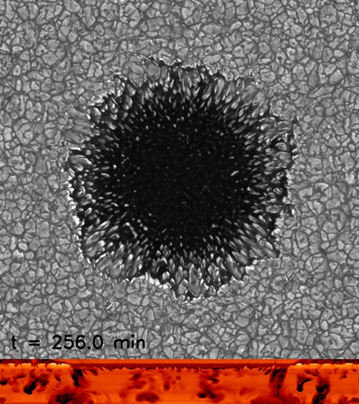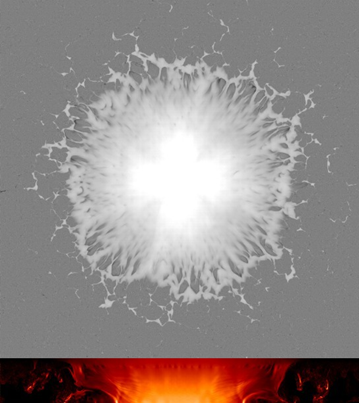Radiative Magnetohydrodynamic Simulations of Solar Atmosphere
JAXA Supercomputer System Annual Report April 2016-March 2017
Report Number: R16E0059
- Responsible Representative: Haruhisa Iijima(Institute for Space-Earth Environment Research, Nagoya University)
- Contact Information: Haruhisa Iijima(h.iijima@isee.nagoya-u.ac.jp)
- Members: Haruhisa Iijima
- Subject Category: Space(Space science,Space philosophy)
Abstract
We investigate the validity of the reduction of the Alfven speed in the solar atmospheric model and implement the method to reduce the computational cost of the simulation. We carry out the full sunspot simulation with about 1/100th smaller computational cost.
Goal
The goal of this project is to contribute the understanding of the highly nonlinear physical processes in the solar observations through the simulations of the self-consistent dynamical modeling of the solar atmosphere.
Objective
The purpose of this project is to reduce the computational cost of the solar atmospheric simulation for the full sunspot simulations that will help the understanding of the dynamo activity and the upper layer of the sunspots.
References and Links
N/A
Use of the Supercomputer
We carry out the full sunspot simulation with the artificial limiting of the Alfven speed on JSS2 system.
Necessity of the Supercomputer
In the radaition magnetohydrodynamic simulation of the solar atmosphere, we have to simulate the spatial structure of order 1,000-100,000 km, resolving the turbulence of order 100 km in space with highly nonlinear structure with shock waves. The super computer is essential for the theoretical study of the solar atmosphere.
Achievements of the Year
The artificial limiting of Alfven speed for the reduction of the computational cost with strongly magnetized region has been suggested. We investigate the validity of the method using the one-dimensional simulation and implement in our three-dimensional atmospheric model. After we confirm the validity of the method in small three-dimensional test simulations, we carry out a simulation that includes the typical sunspot in a box (Fig. 1, 2). The convective energy transport is reduced in the strongly magnetized region and the sunspot is spontaneously formed in the simulation. We are planning to study the dynamo parameters and the atmosphere above the sunspot using our model.

Fig.1:Radiative magnetohydrodynamic simulation of the sunspot. Emerging bolometric radiative intensity viewed from above (Top) and the vertical slice of the horizontal perturbation of the entropy (Bottom) is shown

Fig.2:Same as Fig. 1 but showing the vertical magnetic field on the average height of the bolometric optical depth unity (Top) and the vertical slice of the amplitude of the magnetic field.
Publications
N/A
Computational Information
- Parallelization Methods: Process Parallelization
- Process Parallelization Methods: MPI
- Thread Parallelization Methods: n/a
- Number of Processes: 2048
- Number of Threads per Process: 1
- Number of Nodes Used: 64
- Elapsed Time per Case (Hours): 100
- Number of Cases: 1
Resources Used
Total Amount of Virtual Cost(Yen): 449,446
Breakdown List by Resources
| System Name | Amount of Core Time(core x hours) | Virtual Cost(Yen) |
|---|---|---|
| SORA-MA | 271,786.15 | 439,685 |
| SORA-PP | 0.00 | 0 |
| SORA-LM | 0.00 | 0 |
| SORA-TPP | 0.00 | 0 |
| File System Name | Storage assigned(GiB) | Virtual Cost(Yen) |
|---|---|---|
| /home | 9.54 | 45 |
| /data | 95.37 | 452 |
| /ltmp | 1,953.13 | 9,263 |
| Archiving System Name | Storage used(TiB) | Virtual Cost(Yen) |
|---|---|---|
| J-SPACE | 0.00 | 0 |
Note: Virtual Cost=amount of cost, using the unit price list of JAXA Facility Utilization program(2016)
JAXA Supercomputer System Annual Report April 2016-March 2017


